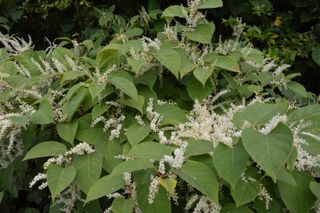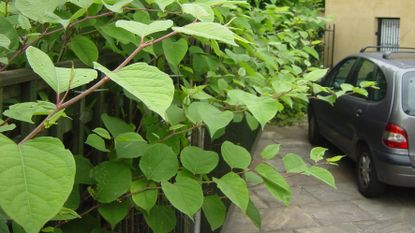Japanese knotweed is now feared and loathed by UK gardeners, so it might surprise you that is was originally brought into Britain for its beauty. It’s not illegal to grow in your garden, but you have to prevent the plant from spreading or face hefty fines. Should Japanese Knotweed encroach onto neighbouring gardens, the local council can also order you to spend thousands of pounds to remove it.
With UK winters getting warmer and wetter, this plant has been thriving and springing up across the country. The Environment Agency has labelled Japanese Knotweed as ‘the UK’s most aggressive and destructive invasive plant,’ so if you find it in your garden, you’ll need to take urgent action.
Find more garden ideas at our dedicated page.
Why does Japanese knotweed need to be removed?
While there is no record of a home ever falling down due to Japanese knotweed, it could have an impact on the saleability of your property. In fact, some lenders will even refuse mortgage applications on the home if it’s found on the mortgage valuation inspection. There have also been cases of homebuyers suing because the weed wasn’t declared on the conveyancing forms.
At its worst, Japanese knotweed can grow up to twenty centimetres each day. The plant can break through tarmac and concrete, and has no natural UK predators to halt its progress. Reaching heights of over two meters, the weed can smother the growth of all other plants and, having evolved to grow on the sides of volcanoes, the knotweed can even resist fires and some herbicides.
Those who do find knotweed on their property will thus find themselves in an ongoing battle trying to keep it at bay, hindering their garden design plans.
Japanese Knotweed identification
Japanese Knotweed spreads through rhizomes – specially adapted underground stems. In early spring, you’ll see fleshy, red-tinged shoots sprouting all over the garden. Once it starts rising up, the Knotweed shouldn’t be hard to spot. The plant has lime green bamboo-like cane stems with purple flecks and spade-shaped leaves arranged in a zigzag pattern. In July, these leaves will host clusters of cream flowers.

Japanese knotweed is easier to identify when in flower around July
How to remove Japanese Knotweed from your garden
If you have the time and determination, it is possible to remove Japanese Knotweed yourself. Generally, the best time to do this is in July, when the plant will draw in chemicals. To get rid of the weed, you will need to decapitate it to leave a hollow, foot-high stem above ground. Then you’ll need to pour a strong, glyphosate-based weed killer into the hollow stem. However, be mindful of the potential harmful effects of this herbicide while using it.
Be careful about disposal
As Japanese Knotweed is classified as ‘controlled waste’ under the Environmental Protection Act, you will have to dispose of it in a licensed landfill site because the weed can still spread through the soil. The whole process may need to be repeated for one or two years to ensure the plant has been successfully eradicated.
Professional knotweed removal
If removing knotweed yourself seems too difficult or you don’t have the time, you can hire professionals to remove the weed. While this can cost between £3,000 and £5,000 for a severe Knotweed problem, a professional service will provide you with a long-term guarantee that the plant will not return. This professional removal may involve using specialist machines to remove the plant and surrounding soil, ensuring the weed is gone for good.
Some removal depends on the plant being in leaf so that they can be sprayed with herbicide. However, this is not always ideal if you are looking to sell your home and want immediate eradication. Environet, Japanese knotweed removal specialists, recommend a system whereby all parts of the plant are given a fatal dose of herbicide, killing the rhizome and preventing regrowth.
How to avoid Japanese knotweed in the first place
If you’re buying a house, it’s a good idea to get a RICS HomeBuyer Report to check there is no Japanese Knotweed on the property. If it’s discovered before you buy, you can negotiate the cost of professional removal from the asking price, avoiding an expensive problem in the future.
As it can be removed and more mortgage lenders are less fearful of it, it can be used as a negotiating tool for the buyer. In fact, research conducted by Environet found that 32% of Brits would still buy a home with Japanese knotweed if the price were reduced. As a buyer, just check that you mortgage lender is aware beforehand – they might have caveats for lending on an affected home.


